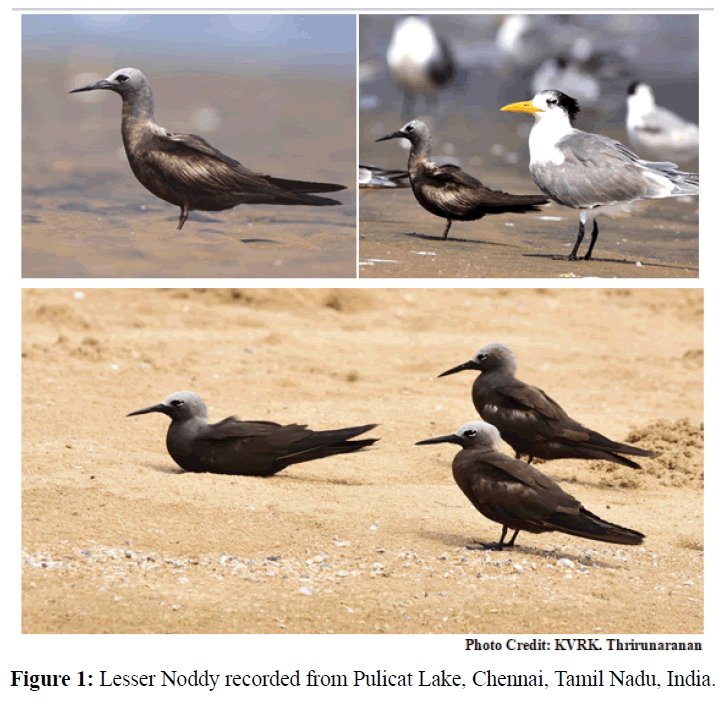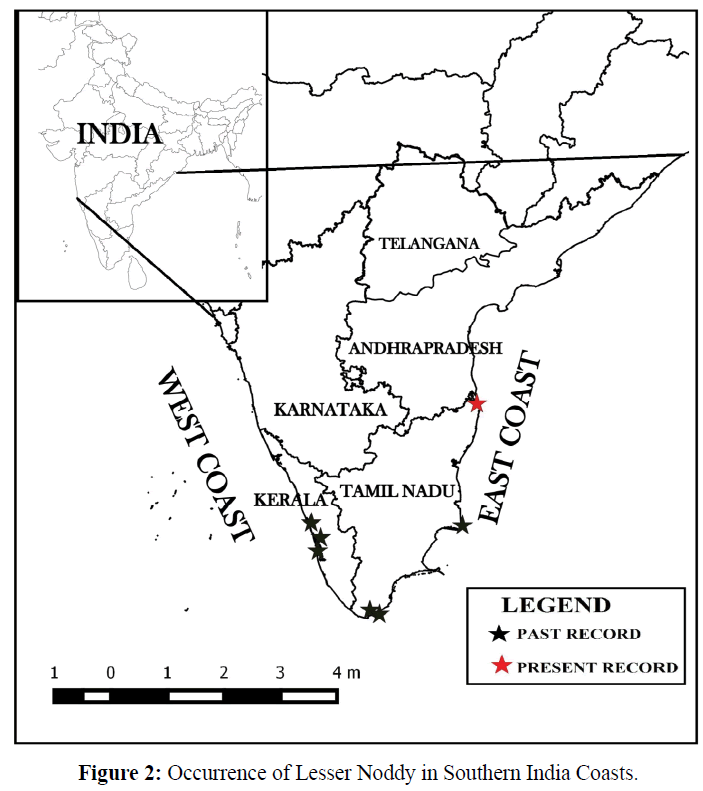Short Communication - International Journal of Pure and Applied Zoology (2020) Volume 8, Issue 4
FIRST RECORD OF PELAGIC LESSER NODDY (Anous tenuirostris) ON EAST COAST IN PULICAT LAKE BIRD SANCTUARY, CHENNAI, TAMIL NADU, INDIA
Thirunaranan KVRK1, Samson A2*, RajkumarM1
1The Nature Trust, Chennai, Tamil Nadu, India
2Vulture Programme, Bombay Natural History Society, Maharashtra, India
- Corresponding Author:
- Samson A
Vulture Programme
Bombay Natural History Society
Maharashtra, India
E-mail: kingvulture1786@gmail.com
Received: 17th July, 2020; Accepted: 28th July, 2020; Published: 03rd Aug, 2020
Abstract
The lesser noddy (Anous tenuirostris), also known as the sooty noddy, is a seabird in the family Laridae. The lesser noddy occurs on islands in the tropical and subtropical Indian Ocean. The present report of the three records showed that it is a first recorded observation of lesser noddy in East coast of Pulicat Lake Bird Sanctuary in Chennai, Tamil Nadu. The present observation of East coast from the month of August and October 2018 from Kanyakumari and Chennai shows that more number of lesser noddies were migrating the East coasts for foraging. Further surveys from the East and West coastlines in the month of April to October non breeding season of lesser noddy is highly warranted to understating their foraging behaviors as well as migrating structure of lesser noddy in the coastlines of southern Indian regions.
Pulicat is the second largest coastal lagoon on the east coast of India. The lake extends over the Ponneri-Gummidipundi taluk of Thiruvallur district in Tamil Nadu and Sulurpeta and Tada taluk of Nellore district in Andhra Pradesh. Situated between 13°24' and 13°47'N latitude and 80°2' and 80°16'E longitude, the lake has an area of 750 km2, about 60km length and with varying from 0.2 km to 175km. During the monsoon, Pulicat receives freshwater through three major rivers namely Swarnamukhi, Kalangi, and Arani. About 2487 (flora and fauna) species inhabit this ecosystem including plants, butterflies, fishes, reptiles, birds, and larger mammals. Due to its varied habitats, the Pulicat Lake is ornithologically rich consisting of several threatened species like the Spot-billed pelican Pelecanusphilippensis. Pulicat supports a significant population of this species and serves as a vital foraging ground. Lake Pulicat is one of the main wintering grounds for waders (shorebirds) in the Central Asian/South Asian Flyway along the east coast of India. The extinct Pinkheaded duck Rhodonessacaryophyllacea was recorded last from the Pulicat Lake.
On 24thApril 2018, 8.44 AM the first observation on a single individual of Lesser Noddy was registered in Pulicat lake Birds Sanctuary hereafter juvenile was spotted in the month of 15th July and finally three individuals were observed on 20th August 2018 in the Pulicat Lake Bird Sanctuary, Chennai, Tamil Nadu, India (Figure 1). The Lesser Noddy was sporadically sighted in the West and East coast of Southern India. A total of three records were done in West Coast of Kerala by Kerala Birds Group (2008) recorded two individuals in the month of July from Beach Marari, Alappuzha district, Hopeland (2016) observed a single individual in the month of August from Cochin coast, Ernakulam district and Raveendran (2018) again a single individual in the month of October from chamakkala beach, Thrissur district. Likewise, three records were done in East coast of Tamil Nadu as well by Balachandran et al. (1986) recorded a single individual from Point Claimer Wildlife Sanctuary in Nagapattinam district, Manivannan et al. (2014) observed a single individual in the month of September from Kanyakumari Coast, Kanyakumari district and Jose Jebaraj (2018) recorded a single individual in the month of August from The Hidden Twins Beach, Kovalam, Kanyakumari district (Figure 2).
Coastal wetlands are special types of wetlands that are influenced by the fluctuating water levels provide a habitat for a vast array of organisms, including many endangered species. Rasmussen &Anderton (2012) reported that Breeding of the Lesser Noddy has been observed from Chagos and the Maldives in the Indian Ocean. It is also reported as a non-breeding visitor to Sri Lanka (De Silva 1979; Robson 2011). Surman et al. (2017) reported that lesser noddy breeds and roosts in mangroves on oceanic islands, and can also sometimes be seen resting on shingle or sandy beaches. A total of 9 records were reported in East and West coast all of the records were done in April to October which is the nonbreeding season (April to August) of the lesser noddy. Birdlife International (2012) reported that before breeding, adult lesser noddies eat large quantities of coral fragments from beaches, presumably as a source of calcium for producing eggs. Montecelli et al. (2014) reported that the smaller Lesser Noddy foraged within 100 km of land over shallower plateau waters adjacent to breeding colonies. Similarly, Villard et al. (2015) suggested that the Black Noddy A. minutus foraged across inshore waters, within the confines of a New Caledonian lagoon. At St. Peter and St. Paul Rocks in the mid-Atlantic ridge, Black Noddies foraged over the oceanic waters surrounding the islands (Naves et al. 2002). Serventy et al. (1971) reported that storm-wrecked individuals have been found as far south as Busselton, Western Australia. A similar kind of statement was stated by Balachandran et al. (1986).
The present report of the three records showed that it is a first recorded observation of lesser noddy in the East coast of Pulicat Lake Bird Sanctuary in Chennai, Tamil Nadu. The present observation of East coast from the month of August and October 2018 from Kanyakumari and Chennai shows that more number of lesser noddies were migrating the East coasts for foraging. Further surveys from the East and West coastlines in the month of April to October nonbreeding season of lesser noddy is highly warranted to understating their foraging behaviors as well as migrating structure of lesser noddy in the coastlines of southern Indian regions.
References
- Balachandran, S., Rajan, S.A. Balasubramanian, P. Natarajan, V., Ali, S.Q. (1986). Some storm-blown pelagic birds in Point Calimere. Journal of the Bombay Natural History Society,83: 436-438.
- Bird Life International (2012).
- De Silva, R. I. (1979). A new addition to the sea-birds of Sri Lanka [Anous tenuirostris worcesteri (McGregor)]. Loris., 15: 28-29.
- del Hoyo, J., Elliott, A. , Sargatal, J. (1996). Handbook of the Birds of the World. 3: Hoatzin to Auks. Lynx Edicions., Barcelona.
- Department of the Environment and Heritage (2005). Population Status and Threats to Ten Seabird Species Listed as Threatened Under the Environment Protection and Biodiversity Conservation Act 1999. Department of the Environment and Heritage, Australian Government, Canberra.
- Harrison, J. (2011). A Field Guide to the Birds of Sri Lanka. Oxford University Press, Oxford.
- Hopeland, P (2017). eBird Checklist: http://ebird.org/ebird/view/checlist?subID= S27442520. eBird: An online database of bird distribution and abundance [web application]. eBird, Ithaca, New York.
- Jose Jebaraj (2017). eBird Checklist: http://ebird.org/ebird/view/checlist?subID= S47855551. eBird: An online database of bird distribution and abundance [web application]. eBird, Ithaca, New York.
- Kerala Birder (2017). eBird Checklist: http://ebird.org/ebird/view/checlist?subID= S27184233. eBird: An online database of bird distribution and abundance [web application]. eBird, Ithaca, New York.
- Manivannan, P., M. Mohan, D. Karuthedathu., K. Muthunarayanan (2014). Lesser Noddy Anous tenuirostris from Kanyakumari coast, Tamil Nadu. Indian. Birds., 9.
- Monticelli, D., J.A. Ramos, T. Catry, P. Pedro., V.H. Paiva (2014). Reproductive parameters of tropical lesser noddies respond to local variations in oceanographic conditions and weather. Estuarine, Coastal and Shelf Science., 139: 110-118.
- Naves, L.C., Brusque, L.C. , Vooren, C.M. (2002). Feeding ecology of Sula leucogaster, Anous stolidus and Anous minutus at Saint Peter and Saint Paul’s Rocks, Brazil. Ararajuba., 10: 21-30.
- Rasmussen, P. C., Anderton, J.C. (2012). Birds of South Asia: the Ripley guide. 2nd ed. Washington, D.C. and Barcelona: Smithsonian Institution and Lynx Edicions. 2; 1-683.
- Raveendran, K.C. (2017). eBird Checklist: http://ebird.org/ebird/view/checlist?subID=S 39986348. eBird: An online database of bird distribution and abundance [web application]. eBird, Ithaca, New York.
- Robson, C. (2011). From the field: Sri Lanka. Birding. ASIA., 15: 111.
- Serventy, D.L., Serventy, V.N., Warham J. (1971). The Handbook of Australian Sea-birds. Sydney, Australia: Reed.
- Surman, C.A., Nicholson, L.W. , Ayling, S. (2017). Foraging behaviour of the Lesser Noddy Anous tenuirostris melanops from the eastern Indian Ocean: insights from micro-geologging. Marine. Ornithology., 45: 123-128.
- Villard, P., Bretagnolle, V., Borsa, P. (2015). Segregation in diet between Black Noddy (Anous minutus) and Brown Noddy (A. stolidus) from the Southern Lagoon of New Caledonia. Pacific Science, 69: 197-204.

